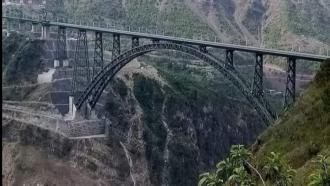
Photo by Yuvraj Singh via Unsplash
Fluids are objects that flow, including liquids and gases. Physicists have long studied their motion using the tools of mathematics. Sometimes, fluid motion appears to be predictable, sometimes they are entirely chaotic, defying any mathematical description. Turbulence, or the chaotic motion of fluids, affects seemingly disparate things like air travel and weather, but remains one of the least understood physics today.
Friction, or resistance between surfaces, plays a crucial role in determining how fluids react to solid surfaces. In a recent study, researchers from the Indian Institute of Technology Bombay (IIT Bombay) have studied how modifying the solid surfaces made of fluid-repelling materials change the fluids’ flow. The study was published in the Journal of Fluid Mechanics.
The researchers studied the motion of water in a square-shaped tunnel containing vertical, transparent cylinders. They coated the cylinders with water-repellant paint, which causes the water to glide over the surface.
“It allows the fluid which comes to the surface to slip,” says Prof Atul Sharma of IIT Bombay, one of the authors of the study.

Schematic image depicting the setup used by the researchers. [Image Credits: Dr P Sooraj, an author of the study (DOI: https://doi.org/10.1017/jfm.2020.371), Department of Mechanical Engineering, Indian Institute of Technology Bombay]
The researchers traced the motion of tiny particles of glass added to the water flowing through the tunnel. By shining a laser on the setup, they caught the glass particles on camera and used the position and timing data of these particles to measure various properties of the flow. They analysed this data to study how the flow changed with speed — whether the flow was stable, whether it followed a pattern that repeated every few seconds, or was chaotic and unpredictable. They noticed that as they increased the water speed in the tunnel from 18 metres/hour to 1.8 kilometres/hour, the flow proceeded from being stable to unstable and ultimately chaotic.
The researchers focused on the back of the cylinder, that is, where the water flowed past it. At low speeds, the water wrapped around the cylinder’s front and back surfaces. As they increased the speed, the water continued to flow around the cylinder’s front surface.
“However, instead of following the surface, the flow on the back leaves it,” shares Prof Sharma. In this region, they observed that the water’s speed would be less than its incoming speed. “The phenomenon is similar to what we see on the back of a ferry,” shares Prof Amit Agrawal, another author of the study.
As the water moves past the solid cylinder, it drags the cylinder along, just like a person in the middle of a river would be. The researchers found that the water-repelling paint was enough to reduce the water’s drag on the cylinder, as if the whole solid is repelling the liquid. The repelling effect is more pronounced at low speeds, when the flow is stable, where they saw a reduction in drag of 15% than over the paintless surface.
“Ours is the first work to consider surface-texturing and consider its implications,” says Prof Sharma, explaining the limitations of previous studies. According to him, the studies considered liquid flow through the internal part of surfaces, like cylinders. The others, which studied flow past external surfaces of cylinders, relied on numerical simulations on the computer instead of direct experiments.
The paint makes it seem as if the water bounces off the solid material. As the particles are repelled, they also rotate along the surface, the researchers observed, which may have interesting consequences. For example, if windshields of cars are coated with such paint, rain falling on the screen may bounce off the screen while simultaneously carrying away dirt, eliminating the need for wipers. Further, vehicles traveling in windy regions consume more fuel to overcome the drag between the surface and the air.
“The effect we observe can lead to a reasonable reduction in fuel consumption of various vehicles in water and air,” says Prof Agrawal, about the change in flow in vehicles coated with water-repellent paint.
This article has been run past the researchers, whose work is covered, to ensure accuracy.

























